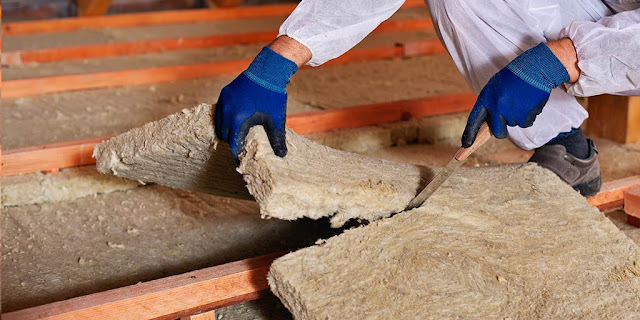How Asbestos Insulation Became Top Reason for the Risk of Asbestos Exposure
Asbestos Insulation: Asbestos was extensively utilized in insulation products for almost a century, posing a significant risk of exposure to numerous individuals. The exposure is closely associated with the development of diseases such as mesothelioma.
Even
today, insulation products containing asbestos remain present in thousands of buildings
across the nation. Some recognizable brands associated with these products
include Zonolite, Kaylo, and Unibestos.
Biphasic Mesothelioma Diagnosis, Cell Types, Treatment & Prognosis
Why Asbestos Used for the Purpose of Insulation?
Asbestos
found extensive use in various insulation products for close to a century. From
the mid-1860s to the late 1970s, this mineral was a common component in
numerous forms of insulation. Its application extended to buildings, machinery,
pipes, boilers, and similar contexts.
Asbestos-based
insulation stands as a major contributor to asbestos exposure, impacting
thousands of workers and residents. Exposure to this hazardous material can
result in severe health complications, including mesothelioma.
The development
of asbestos-related diseases often occurs following the inhalation or ingestion
of microscopic asbestos fibers. This exposure commonly transpires when friable
(easily crumbled) asbestos products are disturbed. Once disturbed, these
mineral fibers can become airborne and readily enter the body.
Asbestos Insulation History at a Glance
Alternate
Names: Block insulation, fill insulation, loose insulation, pipe insulation,
spray-on insulation
Manufactured
Years: 1866 – 1990
Military
Deployment: Aircraft, military barracks, ships, shipyards
Common
Locations of Use: Attics, boilers, buildings, ceilings, factories, floors,
manufacturing floors, residential buildings, sheet packing, ships, walls
Banned Use
of Asbestos: Not banned
Prominent
Brands: Kaylo (produced by Owens-Illinois, Inc.), Unibestos (manufactured by
Pittsburgh Corning), Zonolite (manufactured by W.R. Grace)
Asbestos Insulation Regulations
During the
1970s to the 1990s, various U.S. federal agencies implemented regulations
concerning asbestos-containing materials (ACMs). Key regulatory actions
include:
In 1973,
the Environmental Protection Agency (EPA) prohibited the use of spray-applied
ACMs for fireproofing and insulation.
By 1975,
the EPA banned the installation of asbestos pipe insulation and block
insulation on components like boilers and hot water tanks.
In 1977,
the Consumer Product Safety Commission (CPSC) prohibited asbestos in artificial
fireplace embers and wall patching compounds.
In 1978,
the EPA extended the ban on spray-applied surfacing materials not covered in
the 1973 restriction.
In 1990,
the EPA further restricted materials with spray-on applications containing more
than 1% asbestos.
Products
manufactured before these regulations might still contain asbestos. Presently,
specific types of insulation may contain up to 1% asbestos, as allowed by EPA
guidelines.
Dangers of Asbestos in Insulation
Exposure
to asbestos insulation can lead to the onset of several associated diseases,
including:
- Asbestosis
- Asbestos-relatedcancers
- Laryngeal cancer
- Lung cancer
- Mesothelioma (pleural, peritoneal, and pericardial)
- Ovarian cancer
- Non-cancerous conditions
- Pleural plaques
- Pleural thickening
A study
conducted on insulators in Ireland, tracking 162 individuals from 1940 to 1975,
revealed heightened mortality rates attributed to asbestos-related diseases.
The research observed increased occurrences of mesothelioma, asbestosis, and
bronchial carcinoma among this group.
A
comprehensive study assessing asbestos exposure across 13 different
occupations, including insulators, pipefitters, and sheet metal workers,
highlighted that insulators registered the highest levels of asbestos exposure.
The study
noted escalated exposure levels spanning from the 1940s to the 1950s.
Subsequently, as industrial hygiene practices advanced, exposure began to
decline by the 1970s. This reduction coincided with the introduction of
regulatory measures by agencies like the Occupational Safety and Health
Administration (OSHA) and the Environmental Protection Agency (EPA), aimed at
controlling asbestos use.
It's
important to note that while higher levels of asbestos exposure don't
automatically guarantee an asbestos-related disease, such exposure remains the
primary cause of mesothelioma. Any degree of exposure to asbestos holds the
potential to lead to an asbestos-related illness, such as mesothelioma or
asbestos-related lung cancer.
U.S.
regulatory agencies have actively pursued efforts to mitigate asbestos exposure
through the implementation of regulations and standards governing the handling
of this mineral.
Sarcomatoid Mesothelioma Treatment, Diagnosis Survival and Sub types
List of Asbestos Insulation Products
Please
check the below listed asbestos insulation products commonly used before 1980
across industries such as construction, metalworking, and shipbuilding. These
products included:
Asbestos
canvas
Asbestos
rope
Asbestos
sheets
Asbestos
spray
Asbestos
wool
Attic
insulation
Block
insulation
Calcium
silicate
Cork
covering
Insulation
Lagging
Marinite
Millboard
Pipe
insulation
Rollboard
Sheet
packing
Silicate
calsilite
Sponge
block
Vermiculite
Wicking
These
products were prevalent in multiple industries due to their heat-resistant and
insulating properties, commonly utilized in applications involving high
temperatures or manufacturing processes requiring insulation.
Types of Asbestos Insulation
Asbestos
insulation was employed for its resilience and resistance to heat and
chemicals, and it can be categorized into four primary types based on its
application and composition:
Block
Insulation
The description you provided points to "block insulation," a type of insulation commonly found in semi-rigid slabs or blocks primarily composed of nearly pure asbestos. This type of insulation posed significant risks due to its high asbestos content. It was frequently employed to insulate various equipment, notably boilers, and was also utilized within wall structures.
Insulation Wrapping
The
insulation you're describing fits the characteristics of "pipe
insulation" made from asbestos. It was customarily molded to fit tightly
around pipes, ducts, and plumbing systems. Over time, this insulation tended to
degrade, becoming crumbly and releasing asbestos fibers into the air if
disturbed. Its widespread use aboard ships poses a specific risk to naval veterans
due to their potential exposure to this type of insulation.
Loose-fill Insulation
The
description matches "attic insulation," a fluffy asbestos material
commonly utilized in buildings to insulate attics and walls. This insulation
was intended to fill empty spaces within structures and could be poured or
blown into these areas. Due to its loose composition, it was highly susceptible
to becoming airborne with minimal disturbance, posing a significant risk as
asbestos fibers could easily be released into the air.
Spray-on Insulation
The
insulation you're referring to aligns with "spray-on insulation,"
designed to streamline the installation process by being applied on ceilings
and walls. However, this type of insulation is prone to damage, and any disruption
can lead to the release of asbestos fibers. The U.S. has implemented stringent
restrictions on spray insulation since 1990 due to the associated risks of
asbestos exposure.
Please
note that a variety of insulation products potentially contained asbestos,
extending beyond the commonly recognized types. These included:
Cement:
Asbestos was incorporated into cement-based products for its strength and heat
resistance.
Electrical
Panels: Some electrical panel components contained asbestos due to its
insulating properties.
Plaster:
Asbestos was utilized in certain types of plaster for its fireproofing
qualities.
Batt
Insulation: Certain brands of batt insulation might have included asbestos for
its insulation properties.
The
decision to use asbestos in these products was influenced by its ability to
endure high temperatures and its cost-effectiveness in manufacturing.
Consequently, numerous companies integrated asbestos into their products to
benefit from these advantageous properties.
How to Find the Best New York Mesothelioma Attorneys for Filing
Your Claim
Asbestos Insulation Brand Spotlight
Insulation
products frequently contained notably high concentrations of asbestos. For
instance, certain millboard variants reportedly comprised as much as 85%
asbestos content. These products found widespread use in both residential and
commercial building construction.
The
prevalence of asbestos insulation extended to diverse settings like businesses,
factories, homes, hospitals, and schools.
Additionally,
asbestos insulation wasn't solely limited to standalone insulation products; it
was also utilized as lining material for various components such as boilers,
steam pipes, and valves. This industrial application of asbestos insulation was
commonplace within factories and plants across the United States.
Numerous
manufacturers incorporated asbestos into their insulation materials. These
manufacturers often engaged in the distribution and installation of these
products through other asbestos companies. Moreover, companies frequently
acquired and traded brands, complicating the process of tracing the responsible
manufacturer.
Throughout
the years, a multitude of companies were involved in the production and sale of
asbestos insulation, contributing to its widespread use across various
industries and settings.
List of Companies That Produced Asbestos Insulation
&S
(ACandS)
Amatex
Corporation
Armstrong
Contracting and Supply
Celotex
Corporation
Combustion
Engineering
Crown Cork
& Seal Company
E.J.
Bartells Company
Eagle
Picher
The
Flintkote Company
GAF
Corporation
Garlock
Sealing Technologies
H.K.
Porter (a brand from Apex Tool Group)
Johns-Manville
Kaiser
Gypsum Company, Inc.
Keene
Corporation
Melrath
Gasket, Inc.
Metalclad
Insulation Corporation
National
Gypsum Company
New
England Insulation
Nicolet/Keasbey
& Mattison
Owens-Corning
Fiberglas
Pittsburgh
Corning (UNARCO Industries)
Raybestos/Raymark
Industries, Inc.
Rock Wool
Manufacturing Company
Turner
& Newall
USG
Company (United States Gypsum Company)
W.R. Grace
The
history of asbestos use reveals that many companies were indeed aware of the
associated risks of asbestos exposure.
Despite
this knowledge, several companies failed to adequately protect their employees
from the dangers posed by asbestos-containing materials.
Consequently,
thousands of workers and consumers were exposed to these hazardous materials,
leading to significant health concerns related to asbestos exposure.
This
negligence in safeguarding individuals from asbestos exposure resulted in
severe health implications for many individuals who came into contact with
these materials, particularly in industries involving insulation and related
asbestos-containing products.
Who Is at Risk of Asbestos Exposure From Insulation?
Asbestos
exposure to asbestos insulation posed significant risks to a wide range of
individuals, including workers, consumers, and bystanders.
Certain
occupations, especially those directly involved in handling asbestos products,
faced almost constant exposure to these materials.
Such
individuals are at a higher risk of developing asbestos-related diseases like
mesothelioma due to prolonged and consistent contact with asbestos-containing
products.
Throughout
a considerable portion of the 20th century, asbestos insulation was essentially
unavoidable in specific environments.
Notably,
the U.S. Navy mandated the use of asbestos aboard its ships for an extended
period, exposing countless naval personnel to the mineral.
While some
occupations encountered asbestos sporadically, it's crucial to note that any
level of asbestos exposure carries inherent risks.
Even
intermittent exposure to asbestos-containing materials can be hazardous and
potentially lead to severe health complications
Top Reasons Why Military Personnel Become Easy Target of
Occupational exposure stands as one of the primary routes of encountering asbestos. However,
secondhand or secondary exposure to asbestos can be equally perilous.
This
occurs when asbestos fibers settle on the clothing or belongings of individuals
who work directly with asbestos-containing materials.
Later,
these fibers can be disturbed when handling contaminated clothing or items,
leading to their inhalation by family members and loved ones.
Even
though individuals experiencing secondary exposure to asbestos may not have
worked directly with asbestos, inhaling these disturbed fibers still poses
significant health risks.
Secondary
exposure is known to cause mesothelioma and other asbestos-related diseases,
highlighting the severe implications of inadvertent contact with asbestos
fibers brought home by those working in asbestos-rich environments.
Why Asbestos Gloves Are Being Used Despite Ban?
Asbestos Lawsuits, Settlements & Other Compensation
Please
note that victims of asbestos exposure who have developed asbestos-related
diseases may pursue compensation for their damages. They can seek legal
recourse from parties responsible for their exposure to asbestos.
Compensation
can take various forms, and victims have avenues such as trust fund claims,
lawsuits, or settlements to pursue.
Several
notable asbestos insulation companies have established trust funds to address
claims from asbestos victims.
Some of
these trusts include Celotex Corporation, Combustion Engineering, Garlock
Sealing Technologies, Johns-Manville Corporation, and W.R. Grace, among others.
Claimants
can directly file with these trusts to seek compensation, and legal
representation from an asbestos lawyer can assist in gathering necessary
information for mesothelioma claims. Collectively, over $30 billion is set aside
in various asbestos trusts to aid victims.
However,
not all asbestos companies have established trust funds. In such cases,
individuals may opt to file an asbestos lawsuit.
Lawsuits
can potentially result in asbestos settlements or court verdicts that provide
compensation to affected individuals.
Insulation Case Set Precedent for Future Asbestos Litigation
The Borel
case, stemming from asbestos exposure leading to asbestosis and mesothelioma,
was filed against ten asbestos companies in 1969.
Initially,
four defendants settled the case outside of court.
The
remaining six companies, including Armstrong Cork Corporation, Fibreboard Paper
Products Corporation, Johns-Manville Corporation, Philip Carey Corporation,
Pittsburgh Corning Corporation, and Ruberoid Corporation (a Division of GAF
Corporation), proceeded to trial.
Unfortunately,
Borel passed away before the case concluded, prompting his wife to assume the
role of plaintiff.
Following
the trial, all six remaining defendants were found liable, and Borel's wife
received the jury award in the case.
This legal
battle stands as a significant landmark in asbestos litigation and is
recognized as such by the American Museum of Tort Law.
The
outcome of the case set a precedent and served as an important reference point
in the history of asbestos-related legal proceedings, highlighting the
liability of companies in cases of asbestos-related illnesses.
Safely Removing Asbestos Insulation
The
presence of asbestos insulation in older buildings, factories, and various
equipment remains a concern.
Asbestos
removal poses significant risks, and professionals involved in asbestos
abatement must adhere to stringent guidelines to ensure safety.
Handling,
removing, and disposing of asbestos and asbestos-containing products should be
exclusively managed by qualified asbestos abatement professionals.
Mishandling
asbestos insulation can cause the release of airborne fibers, heightening the
risk of exposure.
Consequently,
the Environmental Protection Agency (EPA) strongly advises against the general
public attempting to handle or remove asbestos due to the associated hazards.
Abatement
specialists are mandated by the EPA to undergo specific training and
certification.
These
professionals possess comprehensive knowledge and are committed to adhering to
federal and state laws governing asbestos handling and removal.
These
regulations are established to safeguard individuals from the potential risks
of asbestos exposure.
Additionally,
other regulatory bodies like the Consumer Product Safety Commission (CPSC) and
the Occupational Safety and Health Administration (OSHA) have their own set of
regulations, rules, and requirements concerning asbestos handling. Their
measures are implemented to ensure the proper management and safety protocols
are followed in handling this hazardous mineral.
Should Homeowners Handle Asbestos?
Handling
asbestos products without proper expertise can pose severe risks.
Asbestos
removal is a task that should strictly be left to professionals. Asbestos
insulation, commonly found in older homes and building materials, presents
significant hazards.
Homeowners
might inadvertently mishandle it, especially if they are unaware of its
presence. Complicating matters, asbestos insulation can sometimes be mistaken
for fiberglass insulation, further increasing the risk of accidental exposure.
If there's
a suspicion of asbestos in a home or building, it's crucial to engage the
services of a certified asbestos abatement specialist.
These
professionals are equipped to conduct asbestos testing and, if found, safely
remove and dispose of any materials containing asbestos.
This
approach ensures that proper protocols are followed, minimizing the risks
associated with asbestos exposure.
How Exposure to Asbestos Popcorn Ceilings Bound to Cause




Comments
Post a Comment